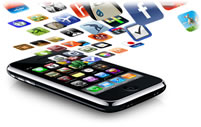 There has been a lot of controversy lately about how Apple handles iPhone app store submissions. The app store is a strange distribution platform. It is similar to past distribution platforms in some ways, but has its own unique mix of problems.
There has been a lot of controversy lately about how Apple handles iPhone app store submissions. The app store is a strange distribution platform. It is similar to past distribution platforms in some ways, but has its own unique mix of problems.
Previous to the iPhone app store, software on mobile phones worked one of two ways. The first was that a developer could get an application on a phone only with the approval of the phone company, phone manufacturer, or both. The second was that a user could download and install software through their computer. Some phones only supported the first method, while others allowed both.
The problem with the first method was that developers had to figure out how to get their apps into the system so they could be downloaded on to the phones. Some systems didn’t even reveal to the public how it worked. As a developer, you had to track down the right people, make connections, set up meetings, spend money, and convince someone to get your app on to the phone. Even then, you had further convincing to do if you wanted your app to appear in the phone’s listing of purchasable applications in such a way that you might actually get people to notice it.
Phone companies favored apps by established developers with brand-name licenses. New or small developers had very little chance of getting the app listed on the phone. It was like retail — there was only so much shelf space and getting your product on the shelves was a mysterious and costly process.
The second method, where users could choose to download an application on their computer and transfer it to the phone, was much more open, as long as the phones and carriers that allowed it. But only a few people would go to all the trouble. A vast majority of mobile phone users would just purchase an app from their phone and wouldn’t bother to learn how to install applications from non-official source. So, for developers, it was tough to make a living doing it this way.
The iPhone app store is definitely in the first category because Apple is the gatekeeper and you have to convince Apple to allow your app to get on the iPhone. But it is different than all of its predecessors in that the app store has room for a virtual infinite number of apps — there isn’t limited shelf space. In addition, Apple has revealed the exact process to get your app to the store, even providing the software development environment, tutorials, a Web portal, etc. They are still the gatekeeper, but they are letting 99% get into the store.
So, what’s the problem?
Well, the problem that people are talking about is that 1% that doesn’t get into the store. Why doesn’t it get in there? Apple apparently follows a set of rules, and has a team of people that try to apply these rules to every app that is submitted. But being people, not machines, they are not all applying the rules in the same way. So whether a developer’s app makes it into the store, depends a bit on chance.
It seems that some of the rules are easy to apply literally and apps were rejected one ridiculous grounds. For instance, a dictionary app was rejected because profanity is not allowed. I guess those words shouldn’t be in the dictionary. An e-book reader was rejected because it is possible to find an e-book copy of the Kama Sutra. You can view that e-book in Safari on the iPhone. Other apps have been rejected on the grounds of “duplicate functionality” such as email clients or podcast feed reading. But these provided alternate methods to do these things, and were clearly not duplicates of existing Apple-created apps.
But rejection isn’t the only nightmare that app developers face. Do you see the apps on the front page of the App Store in iTunes? They probably make a ton of money for the developers. But how about the 50,000 other apps that Apple doesn’t bless with front-page recognition?
Obscurity is just as deadly as rejection in the iPhone app development world. When an individual decides to poor hours, days or months into creating something, only to find it buried in the app store, it spells ruin for that app and that developer.
So there is limited shelf space in the app store. It is still like a retail store, with room to display only so many products. The difference is the iPhone app store has “more in the back” that most people won’t ever bother to ask for.
So in the end, the app store is more like the traditional closed mobile phone app market, restricting success to the few. And it certainly favors large developers and brand names, as anyone who goes to the app store front page can see.
However, the small developer can break out of that and find success — like the American Dream. Let’s call it the “App Store Dream.”
That’s why developers are doing it. Not because they are sure of success, but because they hope for it. And I’m glad they do, because it is clear that this is where innovation will come from. It won’t be from the established developers rehashing their old games or purchasing brand licenses.
I just wish Apple would do more to more to help App Store Dreams come true. They need to speed up the app store review process. They need to use more common sense when approving apps. They need to provide a reasonable remedy system for apps that are rejected so developers don’t have to launch media campaigns to get wrongs righted.
If Apple believed in the App Store Dream, it would not only mean more success for developers, but for the iPhone as well.
Believe in the App Store Dream
Comments: One Response to “Believe in the App Store Dream”
Comments Closed.



I agree that apple favors bigger brand developers on the front page but these developers obviously have the resources to produce high quality stuff that sells well... Why wouldn't apple put those apps up front?
As with any other business, relying so much on someone else is a bad way to run things, which is why as an app developer you should never rely, expect, or even hope for front page exposure on APPLE's website.
Instead, if u put so much effort into developing an app you should put even more of an effort into marketing and promoting your app, and yes, there are free ways to go about doing that. As a bare minimum, you should have a website set up and should be getting as much people to your app's iTunes page ad possible.
You DO have the resouces and the ability to get your app seen, the necesary effort just needs to be applied.